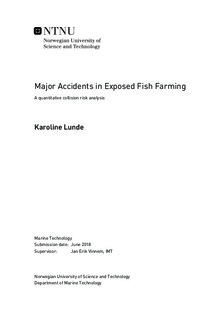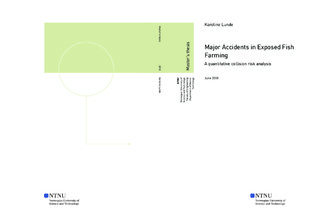| dc.description.abstract | The Norwegian aquaculture industry has had a large increase in activity over the last years, and the expansion is expected to continue in the years to come. However, a further expansion of traditional fish farming is not feasible right now, due to lack of suitable areas and licences. A favorable solution to this problem is to move the production to more exposed waters further away from the sheltered areas near the coast. This thesis will take a closer look at the challenges that arise when moving the fish farming production to such exposed areas, and elaborate how the risk picture changes. It will focus specifically on collision risk, including both passing and attending vessels. The results mainly consist of calculated collision frequencies by using a new version of the COLLIDE model, provided by Safetec Nordic AS. Some simple calculations of the ability to withstand potential collision impact energies are also included.
Due to lack of developed rules and requirements for exposed fish farming, regulations from the oil and gas industry were collected because the conditions around such facilities are assumed to be similar. Because the dimensions and scope in fish farming have been relatively small up until recently, major accident risk assessments have been omitted. It might therefore be beneficial to use knowledge and experience from the offshore industry in order to map major accident risk in exposed fish farming.
In the beginning of this semester a number of potential hazards were collected from the previous project thesis, and only three were selected to be included in the quantitative assessment. These are passing vessel collision risk, attending vessel collision risk and constructional failure risk. This part of the thesis is based on Havfarm 1 by Nordlaks. Its construction, location and other operational details were used as input in the COLLIDE model in order to obtain the desired results.
The total annual collision frequency for Havfarm 1 was calculated to be 5.51E-04. This was the result when adding the frequencies for attending vessel impact and passing vessel collision, which were 4.49E-04 and 1.02E-04, respectively. Still, for impacts above 14 MJ the total collision frequency is 4.67E-05. Frequencies for impacts above 14 MJ caused by attending and passing vessel collision were 3.44E-05 and 1.23E-05. This means that the frequency for attending vessel collision is generally higher than for passing vessels. This is an acceptable tendency because the expected impacts made by attending vessels are lower than for passing vessels, mainly due to lower speed, size and displacement. Even though the total collision frequency exceeds the limit of $10^{-4}$, the severity of impacts below 14 MJ is expected to not lead to loss of main safety functions. For impacts above 14 MJ the frequency is below $10^{-4}$, which is an acceptable result since such high impacts are assumed to cause severe consequences and loss of main safety functions.
Three collision scenarios are assumed. The first is where the vessel hits either the bow or stern. The impact limit was here estimated to lie between 190 and 205 MJ. The second and third cases describe scenarios where the colliding vessel hits the middle of a beam and directly on a transverse beam in the midsection of Havfarm 1. These impact limits were calculated to be 81 MJ and 147 MJ, respectively. The impact limit of 14 MJ is considered by some people to be quite conservative and outdated, and the calculations show that the construction might be able to withstand impacts higher than 14 MJ and still avoid severe consequences that could lead to major accidents.
The entire working process has been challenging, interesting, frustrating at times, and highly educational. It has given greater understanding of the situation in the Norwegian fish farming industry and the challenges it faces. The frequencies obtained in this thesis are assumed to be within the risk acceptance criteria, but this does not mean that one could sit back and never think about risk control and mitigation again. Risk is tentative, and for a different location or facility, the results may not be as acceptable as in this case. The risk picture should always be taken into account in order to maintain a safe fish farming industry. | |

